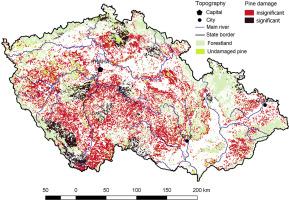Environmental Pollution ( IF 7.6 ) Pub Date : 2020-04-03 , DOI: 10.1016/j.envpol.2020.114352 Pavel Samec 1 , Miloš Zapletal 2 , Petr Lukeš 3 , Pavel Rotter 4

|
Scots pine (Pinus sylvestris L.) is a widespread unpretentious forest tree-species; however, its adaptability to environmental change differs among sites with various buffering capacity. In this study, we compared the effect of precipitation and nitrogen deposition (ND) on biomass density in natural and man-made pine stands of differing soil fertility using lag geographically weighted multiple regression (LGWMR). Soil fertility was defined using ecological series as zonal trophic (27.9%), acidic (48.2%) gleyed (15.2%) and as azonal exposed (2.5%), maple (2.4%), ash (0.8%), wet (2.1%) and peat (0.9%) of the Czech Republic in Central Europe (4290.5 km2; 130–1298 m a.s.l.). Annual precipitation and ND in every pine stand were estimated using zonal statistics from 1 × 1 km grid for years of severe non-specific forest damage spread. Biomass density was obtained from a MODIS 250 × 250 m raster using the normalized difference vegetation index (NDVI) for years 2000–2014, with a decrease in NDVI indicating non-specific damage. Environmental change was assessed by comparing predictor values at NDVI time t and t+λ. Non-specific damage was registered over 51.9% of total forest area. Less than 8.8% of damaged stands are natural and the rest (91.2%) of damaged stands are man-made. Pure pine stands are more damaged than mixed. ND stand damage is more significant than damage due to the precipitation lack since 2007. ND during 2000–2010 decreased NDVI the most significantly at 2012. Exposed natural pine sites are the most sensitive to environmental change (R2 = 0.11–0.86). The most widespread man-made pine stands on acidic sites are damaged at more open significance interval (R2 = 0.07–0.88). Mixed forest and sustainable management at natural sites provide effective remediation reducing damage by ND.
中文翻译:

干旱和氮沉降对赤松(Pinus sylvestris L.)损害的空间滞后效应。
苏格兰松(Pinus sylvestris L.)是一种普遍的朴实的森林树种。但是,对于具有各种缓冲能力的站点,其对环境变化的适应性也有所不同。在这项研究中,我们使用滞后地理加权多元回归法(LGWMR),比较了不同土壤肥力的天然和人造松林中降水和氮沉降(ND)对生物量密度的影响。土壤肥力通过生态学系列定义为:带区营养(27.9%),带酸性(48.2%),变质(15.2%)和带区暴露(2.5%),枫树(2.4%),灰分(0.8%),湿润(2.1%) )和中欧(4290.5 km 2)的泥炭(0.9%); 130-1298 m升)。使用1×1 km网格的区域统计数据,估算了多年严重非特定性森林破坏的蔓延情况下,每个松林中的年降水量和ND。使用2000–2014年的归一化差异植被指数(NDVI)从MODIS 250×250 m栅格中获得生物量密度,NDVI的降低表明存在非特异性损害。通过比较NDVI时间t和t的预测值评估环境变化+λ。非特定损害记录在森林总面积的51.9%以上。不到8.8%的受损林分是自然的,其余(91.2%)受损林分是人为的。纯粹的松木林比混合林受到的破坏更大。自2007年以来,由于缺乏降水,ND林分破坏比破坏更为严重 。2000- 2010年ND下降NDVI在2012年最为明显。裸露的天然松树对环境变化最敏感(R 2 = 0.11-0.86)。酸性地区最广泛的人造松林以更显着的显着性区间受到破坏(R 2 = 0.07–0.88)。天然林的混合森林和可持续管理提供了有效的补救措施,减少了ND造成的破坏。









































 京公网安备 11010802027423号
京公网安备 11010802027423号